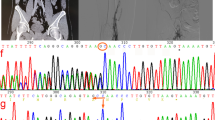Abstract
VTE is a complex disorder with two main manifestations: DVT and PE. Deficiency of natural anticoagulants plays an important role in the pathogenesis of VTE. Antithrombin (AT) deficiency is one of the most common hereditary thrombophilia in Asia. Subjects with AT deficiency have two mutations in the same allele of the SERPINC1 gene: p.Arg45Gln and p.Ser114Arg (Arg13Gln and Ser82Arg, according to the antithrombin mutation database). DNA sequencing, ELISA (enzyme-linked immuno sorbent assay), plasmid transfection, and homology modeling were performed to study the molecular pathophysiological mechanism of the deficiency. Recombinant expression of these mutations demonstrated a relevant functional effect on the p.Ser114Arg mutation, since it almost abolished the secretion of AT to the conditioned medium and increased intracellular retention, while the p.Arg45Gln mutation had negligible effects. Homology modeling showed that some atoms from Arg114 interfered with the atoms of the β-strand, the abstract power between Arg45 and S2 was larger than that between Gln45 and S2, and the electrostatic energy (−617.281 to −452.079 K) was the primary contributor to this difference. The functional mutation responsible for the deficiency of this potent anticoagulant p.Ser114Arg probably has conformational consequences on the folding of the protein leading to its intracellular accumulation and impaired secretion.



Similar content being viewed by others
References
Mei BC, Qi PJ, Kai FL et al (2000) Research of antithrombin deficiency in venous thromboembolism patients. Chin J Inter Med 39:746–748
Shen MC, Lin JS, Tsay W (1997) High prevalence of antithrombin III, protein C and protein S deficiency, but no factor V Leiden mutation in venous thrombophilic Chinese patients in Taiwan. Thromb Res 87:377–385
Liu HW, Kwong YL, Bourke C et al (1994) High incidence of thrombophilia detected in Chinese patients with venous thrombosis. Thromb Haemost 71:416–419
Lane DA, Bayston T, Olds RJ et al (1997) Antithrombin mutation database:2nd(1997) update [J]. Throm Haemost 77:197–211
Yamada H, Hoshi N, Kato EH et al (2000) Novel mutation (E113X) of antithrombin III gene (AT3) in a woman with gestational recurrent thrombosis. Am J Med Genet 91:348
Deng Haoyu, Shen Wei, Yi Gu et al (2012) Three case reports of inherited antithrombin deficiency in china: double novel missense mutations, a nonsense mutation and a frameshift mutation. J Thromb Thrombolysis 34(2):244–250
van Boven HH, Lane DA (1997) Antithrombin and its inherited deficiency states. Semin Hematol 34(3):188–204
Snav V, Qaseem A, Barry P et al (2007) Management of venous thromboembolism: a clinical practice guideline from the American college of Physicians and the American Academy of Family Physicans. Ann Inter Med 146:204–210
Kim ESH, Bartholomew JR (2010) Venous thromboembolism contemporary cardiology. Antithrombotic drug therapy in cardiovascular disease 6:331–350
Carrell RW, Huntington JA, Mushunje A et al (2001) The conformational basis of thrombosis. Thromb Haemost 86(1):14–22
Corral J, Vicente V, Carrell RW (2005) Thrombosis as a conformational disease. Haematologica 90(2):238–246
Corral J, Huntington JA, González-Conejero R et al (2004) Mutations in the shutter region of antithrombin result in formation of disulfide-linked dimers and severe venous thrombosis. J Thromb Haemost 2(6):931–939
Quinsey NS, Fitton HL, Coughlin P et al (2003) Introduction of a mutation in the shutter region of antithrombin (Phe77 –> Leu) increases affinity for heparin and decreases thermal stability. Biochemistry 42(34):10169–10173
Beauchamp NJ, Pike RN, Daly M et al (1998) Antithrombin Wibble and Wobble (T85 M/K): archetypal conformational diseases with in vivo latent-transition, thrombosis, and heparin activation. Blood 92(8):2696–2706
Picard V, Bauters A, Khairy M et al (2005) Conformational Asn187Asp/Lys antithrombin variants and thrombosis. Clinical and biological features in 13 new heterozygotes. Thromb Haemost 93(1):57–62
Fitches AC, Lewandowski K, Olds RJ (2001) Creation of an additional glycosylation site as a mechanism for type I antithrombin deficiency. Thromb Haemost 86(4):1023–1027
Schedin-Weiss S, Desai UR, Bock SC et al (2004) Roles of N-terminal region residues Lys11, Arg13, and Arg24 of antithrombin in heparin recognition and in promotion and stabilization of the heparin-induced conformational change. Biochemistry 43(3):675–683
Acknowledgments
We are grateful to the patient and his family members for their participation in this study; we would like to thank Beijing Genomics Technologies for its help in the analysis of the exome sequencing data. We also feel obliged for the support from a Key Discipline Project of Renji Hospital, Shanghai Jiaotong University School of Medicine (RJ4101309), Shanghai science and technology foundation program (No.10ZR1418800).
Author information
Authors and Affiliations
Corresponding author
Additional information
H. Deng, Y. Gu and J. Xie contributed equally to this work.
Rights and permissions
About this article
Cite this article
Deng, H., Chen, J., Xie, H. et al. Rare double heterozygous mutations in antithrombin underlie hereditary thrombophilia in a Chinese family. J Thromb Thrombolysis 36, 300–306 (2013). https://doi.org/10.1007/s11239-012-0822-7
Published:
Issue Date:
DOI: https://doi.org/10.1007/s11239-012-0822-7




